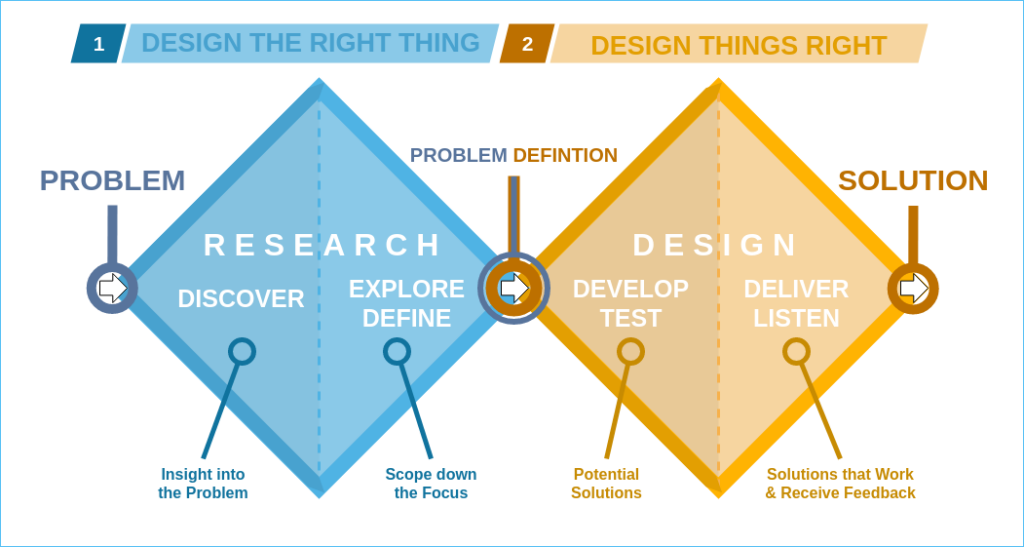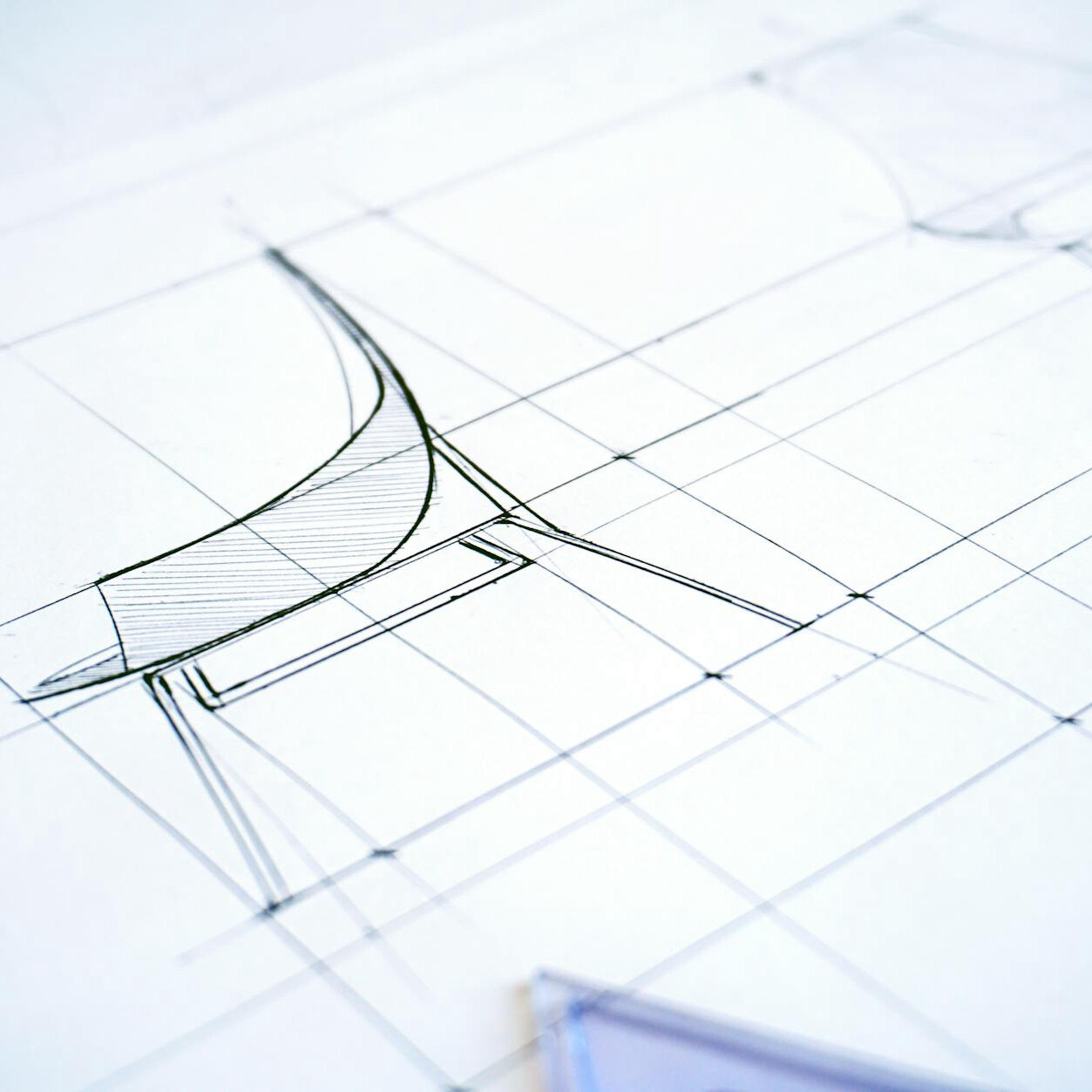Unlocking Double Diamond UX Design Methodology
The Double Diamond design process model was developed by the British Design Council in 2005. It is a visual representation of the design process, emphasizing the importance of divergent and convergent thinking in problem-solving. The model is called “Double Diamond” because it consists of two diamond-shaped diagrams that represent the four distinct phases of the design process: Discover, Define, Develop, and Deliver.
The Double Diamond model has since been widely adopted by designers, particularly those in the field of UX (User Experience) design, as it offers a clear framework for tackling complex problems and generating innovative solutions. The method encourages designers to explore and understand the problem space, clearly define the problem, ideate and prototype potential solutions, and finally refine and deliver a final solution.
Maximize the benefits of the Double Diamond method and enhance your UX design problem-solving skills
When utilizing the Double Diamond method, it’s important to keep several key considerations in mind to ensure the process runs smoothly and effectively:
- Collaboration and communication: Effective collaboration and open communication among team members are crucial for success. Engage stakeholders, designers, developers, and end-users throughout the process to gather diverse perspectives and insights.
- Iterative process: The Double Diamond method is not a linear process. Be prepared to iterate and refine ideas as you progress through the stages. This iterative approach allows for continuous learning and improvement.
- Embrace uncertainty: The early stages of the Double Diamond method involve exploration and discovery. It’s essential to embrace uncertainty and stay open to new ideas and possibilities.
- Balance divergent and convergent thinking: The Double Diamond model relies on alternating between divergent (exploration) and convergent (synthesis) thinking. Understand and manage the balance between these two modes to ensure a successful outcome.
- User-centered approach: Keep the end-users’ needs and expectations at the forefront throughout the process. Conduct user research, develop personas, and utilize user feedback to inform your design decisions.
- Prototyping and testing: Creating prototypes and testing them with users is an integral part of the Develop phase. It helps validate your ideas, identify potential issues, and refine solutions before investing in full-scale implementation.
- Adaptability: The Double Diamond method is a flexible framework that can be adapted to different projects, industries, and organizational contexts. Feel free to adjust the process, tools, and techniques to better suit your specific needs and constraints.
- Documentation and reflection: Document your progress, insights, and decisions throughout the process. This helps maintain a clear project history, facilitates communication, and enables you to reflect on your progress and learn from both successes and challenges.
- Time management: Each phase of the Double Diamond method requires a different amount of time and effort. Allocate time wisely and set clear deadlines to keep the project on track and maintain momentum.
- Continuous learning and improvement: The Double Diamond method is not a one-size-fits-all solution. Learn from each project and continuously refine your approach to improve the effectiveness of the method for future projects.
By keeping these considerations in mind, you can maximize the benefits of the Double Diamond method and enhance your problem-solving capabilities in the field of UX design and beyond.
Real-World Success: Three Case Studies of UX Teams Applying the Double Diamond Methodology
In each of these real-world examples, the UX team leverages the Double Diamond methodology to guide their problem-solving process. They start by discovering user needs and defining the problem, then develop multiple design solutions and iterate based on user feedback before delivering the final product. This structured approach helps ensure that the resulting designs effectively address user needs and provide a satisfying user experience.
Redesigning a mobile banking app:
Discover: The UX team starts by researching the current mobile banking app’s pain points, user behavior, and competitor analysis. They conduct interviews and surveys with users to understand their needs, expectations, and frustrations with the current app.
Define: After analyzing the research findings, the team identifies the primary issues, such as complex navigation, slow loading times, and unclear transaction history. They create user personas and establish clear goals for the redesign, focusing on improving usability and user satisfaction.
Develop: The team generates various design concepts and prototypes to address the identified issues. They explore different navigation structures, visual designs, and interaction patterns. Then, they conduct usability testing with users to gather feedback and refine their prototypes.
Deliver: Based on the feedback, the team finalizes the app design, collaborating with developers to implement the changes. They perform further testing to ensure a seamless user experience and launch the updated app, followed by monitoring user feedback and app metrics for continuous improvement.
Developing an e-commerce website:
Discover: The UX team conducts market research, user interviews, and analyzes existing e-commerce websites to understand user needs, expectations, and preferences for an online shopping experience.
Define: The team synthesizes the research data and identifies key requirements, such as intuitive navigation, personalized product recommendations, and a seamless checkout process. They establish design goals and create user personas to guide their design.
Develop: The UX team creates wireframes, mockups, and interactive prototypes for various design concepts. They explore different layouts, features, and visual elements to enhance the user experience. They then conduct usability tests and gather feedback from users to refine their designs.
Deliver: Once the design is finalized, the team collaborates with developers to build the e-commerce website, ensuring that the user experience is maintained throughout the development process. After launching the website, they monitor user feedback, site performance, and other relevant metrics to identify areas for improvement and make necessary updates.
Improving a digital health platform:
Discover: The UX team begins by researching the digital health platform’s current user experience, including user demographics, pain points, and areas for improvement. They gather data through user interviews, surveys, and analytics.
Define: Based on their findings, the team identifies key issues such as poor user engagement, difficulty finding relevant health information, and limited personalization. They create user personas and define goals for improving user engagement and satisfaction.
Develop: The UX team explores various design solutions, such as improving content organization, incorporating gamification elements, and enhancing personalization features. They create and test multiple prototypes with users to validate their design decisions and make refinements based on user feedback.
Deliver: After finalizing the design, the team collaborates with developers to implement the changes and ensure a smooth integration with the existing platform. They launch the updated digital health platform and continue to monitor user feedback, engagement metrics, and other relevant data to assess the impact of their design improvements. Based on the results, they identify further opportunities for enhancement and iterate on the design as needed.
Related Articles
The Importance of Grids in Design
July 12, 2024
Understanding User Interface (UI)
July 10, 2024
Cognitive Fluency: Enhanced User Experience (UX)
July 10, 2024




